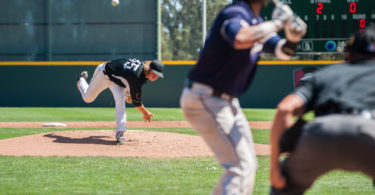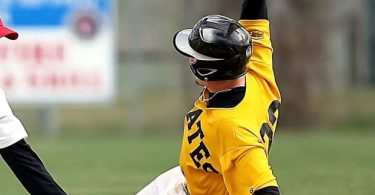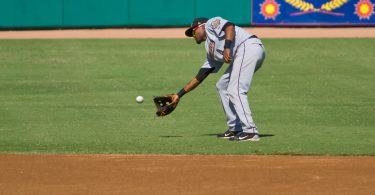The Situation:
It’s the bottom of the 6th inning in a tight playoff game. The score is 3-3 and there are runners on 1st and 3rd with no one out.
The Play:
With a 1-2 count, the right-handed batter gets out front of a breaking ball and lofts a medium fly ball to left field—a routine fly ball for the well-positioned outfielder. The runner at 3rd goes back to the bag to tag up and the runner on first extends ‘as far as he can go’. The outfielder positions himself behind the ball and makes the routine catch, coming up firing towards home.
The runner at third takes off for home as the runner at first retreats to the bag. The throw sails over the head of the third base cut-off man, but is strong and online. The third base coach, having moved well down the line to assist the tagging runner sees the strong throw and puts his hands up to hold the runner up late. The runner at third puts the breaks on a third of the way down the line and scrambles back to 3rd base. The throw easily would have had him out at home, reaching the catcher waist high on the third base side of home plate. The runner at first hustles back to first and reads the play, but it’s too late for him to advance on the overthrown cutoff man.
The Outcome:
On the very next pitch, the batter bounces into a 6-4-3 double play and the visiting team escapes a huge jam to preserve the 3-3 tie. They have seized the momentum back.
What went wrong:
You might think that the mistake is the outfielder overthrowing the cutoff man, but given the situation, that’s not the biggest issue here. Instead, we want to focus our attention on the offense, and specifically the runner at 1st base. With runners on 1st and 3rd, the defense is a strikeout and a double play away from getting out of the inning, or in this case, a shallow fly out and a double play.
Runners at first are often told to “extend as far as you can” or “go half-way” with less than two outs, but these catch-phrases don’t account for situational strategy and are very basic. More is expected of runners at higher levels of baseball.
On a routine fly ball to left, the runner at first has the advantage of having the entire play in his field of view. After reading the ball as a routine fly ball, the runner at first should have retreated to the bag to tag up and put pressure on the defense. This would result in several better outcomes for the offense:
- Scenario 1: The outfielder still throws to home and the throw sails over the cut-off man just as it did. This allows the tagging runner at first to move to second easily, eliminating the double play and forcing the defense to still get out of a difficult jam.
- Scenario 2: The outfielder sees or is alerted of the tagging runner. He decides to play it safe and keep the double play in order and concede the run. He throws to second where the runner at first can 1) Read it and get back to first safely, or 2) Try to make it to second. Even if he is punched out at second in a worst-case scenario double play, the offense gains the lead. Since the entire play is in the runner’s view as he runs to second, this would be a judgment read. Either way, the offense takes the lead and improves their situation over a non-scoring outcome.
- Scenario 3: The outfielder somehow whiffs on the ball. Even if the runner at 1st is thrown out at second because he was tagging up, the runner from 3rd will score, again giving the offense the lead and only costing the team one out.
No matter how it plays out, tagging at 1st will put pressure on the defense and allow for the runner to read the play and make a well-informed decision based on how the play develops. These situations are difficult to think of in the moment, so it’s important to do your homework ahead of the play and think the game!







